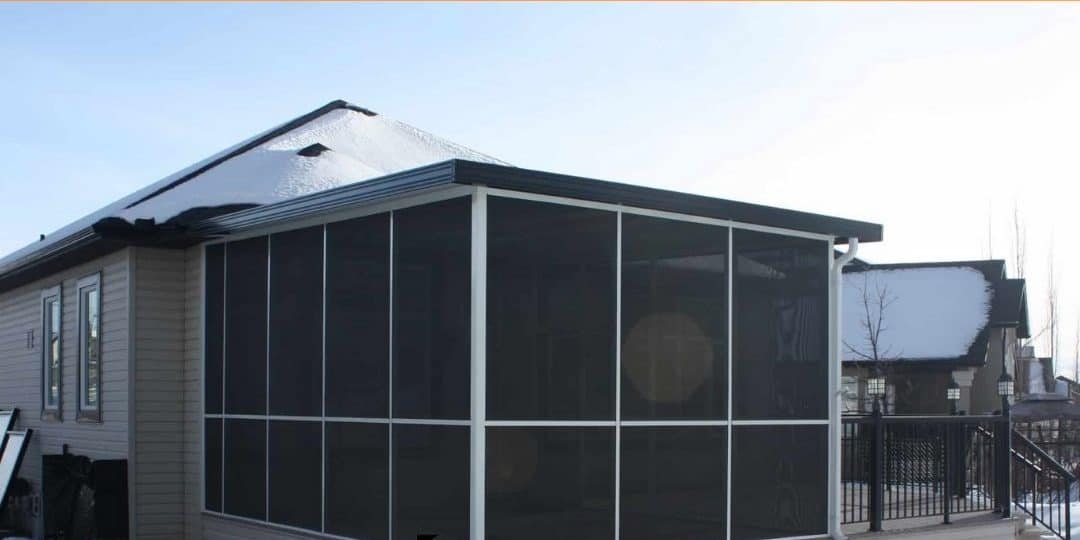During summer, you don’t need to worry much about maintaining your screen room. Any debris that gets stuck to the mesh will either get washed away by the summer rains or can simply be washed down with a damp cloth. Your furniture in the screen room should dry out quickly with the wind and heat in the case of a heavy rainstorm. All of this means you can spend those long warm months enjoying your screen room to the fullest.
Prepping For Winter Weather
However, as the temperatures start to drop, you need to start thinking about how to prep your screen room for winter. Your screen is set up to survive hot and mild temperatures, but will need support to cope with the freezing Calgary winters and blizzard-like snow storms of winter. Some simple tips to prep your screen room for winter include:
- Put up vinyl sheeting – the biggest way to protect your screen room this winter is to cover the mesh windows with vinyl sheeting. This is a great weekend project, as you’ll need some time to measure and cut the vinyl sheeting to size to completely cover each of the mesh windows. Velcro strips are an easy way to secure the vinyl sheeting to the window frames as they can be removed when spring finally rolls back around, but you can also attach them with small finishing nails as long as you remember to fill the holes when you take them down.
- Store your soft furnishings – it sounds obvious, but even with vinyl sheeting, you may still get some snow in your sunroom, and the temperatures will still drop below freezing on multiple occasions. The last thing you want is to allow your blankets and cushions to freeze as they may not go back to their original comfort levels. Finding somewhere to store then in the winter will keep them fresh and ready for spring.
- Seal the door frame – finally, your home benefits from keeping the connecting doors open during the summer and allowing the summer heat and breezes to circulate your entire home. The opposite is true during winter, as your screen room will act as a heat suck from your home, and you’ll find your heating bills rising dramatically if you don’t fully seal the door frame to your screen room. The seal can be as simple as strips of insulating tape along each side of the door that then expands to fill the gaps when you close it for the season.
Checking In
Prepping your screen room for winter shouldn’t end when you finally leave the room for the season. You should check on your screen room at least monthly and definitely after each major snow storm to make sure that the vinyl sheeting is holding up and that there is no damage to the mesh. Left unchecked, any small holes or defects in your screen room mesh can become larger and harder to fix as the cold and the snow do their damage.
Heating Your Screen Room In Winter
These steps work well for people who want to keep their screen room as a three season room, but there’s no reason not to work on your screen room so you can use it all winter long. You’ll need to install the vinyl screens as outlined above, and then choose a heating option to allow you to use your screen room all winter long:
- Fireplace – if your screen room is large enough, adding a full fireplace will change the whole look and feel of your screen room. Be warned – they can get expensive depending on the materials that you use to create it, and you’ll need to find a way to make a chimney exit that doesn’t blow smoke into your upstairs windows. You’ll find that you don’t need a massive fireplace to keep your screen room warm which means that you can be creative with where you locate it. Finally, you’ll need to think about whether to fuel it with wood (which will mean you’ll need ready access to a wood pile throughout the winter) or gas (which means you’ll need to install a propane tank somewhere near your home).
- Stove – if you’re short on space or looking for something a little cheaper than a full fireplace, then a free standing stove might be a better choice for your winter screen room. These tend to stand less than half a metre high and can be vented through one of your mesh windows or even through the solid walls of your screen room. Again, you’ve got a couple of fuel choices for your stove. Firstly, you can go old fashioned with a wood burning stove. These take a little while to get going but then require minimal effort (and fuel) to last all day long. You’ll need access to a steady supply of wood and have somewhere in your screen room to store it to save yourself having to brave the cold outside. The other option is to go for a pellet stove, which uses small pellets of wood fed into the stove. These stoves need an electrical outlet to control the flow of pellets into the heater, but tend to use less fuel over the course of the season. Just like the wood burning stove, you’ll need somewhere to store the big bags of pellets so you can top up the stove as necessary.
- Electric space heater – if you’re truly on a budget, then you’ll find that an electric space heater will provide enough warmth to use your screen room throughout the winter. They have the benefits that they are small and cheap to purchase, but they can drastically drive up your energy prices and don’t look as beautiful as either of the stove options.







